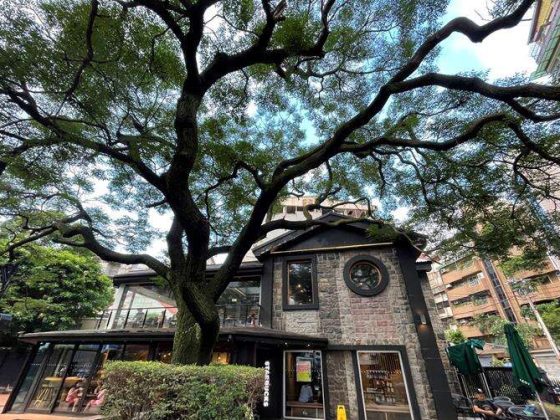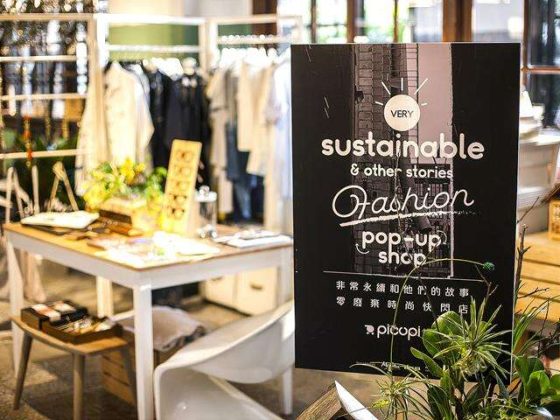Author Kai Ping Fang
Photographer Kai Ping Fang, Te Fan Wang
In the heart of Taipei lies a hidden gem of much cultural cache, the Songshan Cultural and Creative Park (松山文創園區). Once a bustling tobacco factory, this historic site has been transformed into a thriving hub for creativity, innovation, and artistic expression. The park’s conversion, while preserving its industrial heritage, has attracted artists, designers, and entrepreneurs to its unique spaces, breathing new life into the historical landmark.

The Songshan Cultural and Creative Park is more than just a cultural center; it is an embodiment of Taiwan’s creative spirit and dedication to preserving its rich history. The park’s location is steeped in significance, surrounded by some of Taipei’s most historic and culturally remarkable sites. With convenient transportation options, visitors to the park can easily explore the nearby scenic spots and landmarks, including National Dr. Sun Yat-sen Memorial Hall (國父紀念館), the iconic Taipei 101 skyscraper, Xiangshan (象山, Elephant Mountain) hiking trail, and Raohe Night Market (饒河夜市). This fusion of history and innovation has made Songshan Cultural and Creative Park a must-see destination for locals and tourists alike.
To embark on the journey through the story of the Songshan Cultural and Creative Park, we were accompanied by our guide for the day, Chang Cheng Bei (張正北), a retired veteran who was introduced to the world of guiding by a friend. Intrigued by the craft, Chang began researching and creating his own presentations, which led to him developing a set of guiding principles and volunteering as a guide in multiple areas. His passion for cultural exploration has earned him numerous accolades, including the prestigious National Outstanding Cultural Volunteer Bronze Award ( 全國績優文化志工銅質獎) from the Ministry of Culture (文化部) and the Diamond Award for Excellent Volunteer (優良志工金鑽獎) from the Taipei City Government (台北市政府). We were fortunate to have him as our guide as he introduced us to the past and present of this momentous park.

From Tobacco Factory to Creative Hub
Chang began the tour with the history of the Songshan Cultural and Creative Park, or formerly known as the Songshan Tobacco Plant (松山菸廠). The plant, built in 1937 during the Japanese colonial period (1895-1945), was the largest tobacco processing center in Taiwan until its closure in 1998. The plant combined Western and Japanese styles, using the latest technology and focusing on worker hygiene and safety. After Taiwan’s retrocession to the Republic of China, the plant became a state-run enterprise until the 1980s, when it faced financial difficulties due to changing attitudes towards smoking. The factory was eventually closed in 1998 and repurposed for cultural and creative industries, opening to the public in 2011.

The architectural style of the factory belongs to the “early Japanese modernism” school of the “secessionist movement.” It features horizontal sight lines, simple and elegant forms, and specially-customized building materials such as bricks, tiles, and copper nails. The Songshan Tobacco Plant’s workmanship is exquisite, and serves as a pioneer and model of modern industrial factories in Taiwan.
Despite the factory’s eventual closure due to new urban planning, shifts in tobacco industry landscape, awareness to the harmful effects of smoking, and lack of competitiveness, its historical significance remains, and it is now preserved as a cultural and creative hub for the public to enjoy.
Tobacco Leaves to Cigarettes
The processing of cigarettes at the Songshan Tobacco Plant, according to Chang, can be categorized into five departments: box-making, leaf processing, cutting, rolling, and packaging. As soon as the tobacco leaves were transported on site, they would move along the outer buildings on the north, east, and south of the plant where the departments were located.
Chang provided a detailed explanation of the cigarette production process, involving various essential steps like leaf acquisition, flue-curing, preliminary processing, and transportation to the factory. The manufacturing process varied throughout history, with the Japanese colonial period including leaf sorting, cutting, cigarette rolling, drying, packaging, and storage. In contemporary production, the tobacco leaves are initially revealed in their natural form from the raw material warehouse. They undergo conditioning, including cutting, moistening, deveining, and maturing in tobacco barrels to achieve desired qualities. Finally, fully matured leaves are transported to the cigarette.
“The economic value of the Songshan Tobacco Plant to both the Japanese and Taiwanese governments was significant,” Chang explained further. During the Japanese era, the plant supplied cigarettes to soldiers and civilians alike. After Taiwan was returned to R.O.C. control, the plant played a vital role in the economic development of Taiwan by creating jobs, providing a source of income for the Taiwanese people, and generating revenue for the government. Despite the increasing scrutiny on the tobacco industry, the Songshan Tobacco Plant’s legacy remains significant in the history of Taiwan’s industrial development.
A Community Within a Factory
During its peak years, the Songshan Tobacco Plant was not just a factory, but a community. To attract and retain workers, the company provided a range of comprehensive services, including housing, childcare, medical care, a bathhouse, a canteen, and more. The plant had a large residential area on its grounds, consisting of dormitories and apartments, which were assigned to unmarried and married employees respectively. One of the most important services provided by the company was childcare, which offered not only a safe and secure environment for children, but also educational and recreational activities to stimulate their development. The company also provided a variety of medical services, including a medical clinic, which treated everything from minor illnesses and injuries to more serious conditions. In addition, the company organized cultural and recreational activities to foster a sense of community and camaraderie among the workers.
“These comprehensive services provided by the Songshan Tobacco Plant were not only beneficial to the workers, but also to the company and the government,” Chang pointed out as we walked through the park, observing the rooms that the services were provided in. By providing housing, childcare, and healthcare, the company was able to attract and retain a stable workforce, which was essential for its continued growth and success. Moreover, these services served as a demonstration of the company’s commitment to the well-being of its employees and the community, which helped to build goodwill and trust among consumers and regulators. This was particularly important in the tobacco industry, which was and still is subject to strict regulations and scrutiny.
The Unique Little Temple of the Earth Goddess
In Taiwan, the temples dedicated to the Earth God or Tudi Gong (土地公), a widely revered deity around the country, are an integral part of the religious and cultural landscape. Prayers to this god, who is sometimes accompanied by his consort, the Earth Goddess or Tudi Po (土地婆), are offered all across the island in the interest of ensuring safety and security. However, it is a rare occurrence to encounter a temple dedicated solely to the Earth Goddess, as is the case with the temple situated under an aged banyan tree within Songshan Cultural and Creative Park.

Despite the significance of this temple, its origins and purpose remain shrouded in mystery. “No one knows when the temple was built or why it was built. For all we know, it may have been constructed to serve the needs of the female employees, who were substantially higher than their male counterparts,” Chang speculated. “After all, it was thought that a goddess could better understand and empathize with their unique challenges and experiences.”
The Fusion of Heritage and Innovation
The Songshan Cultural and Creative Park is an impressive achievement in preserving history and promoting creativity. For example, the Songyan Creative Hub (松菸創作者工廠), established on the second floor of the South Tobacco Factory (南向製菸工廠), aims to support creators and their originality in the market. The hub provides a space for creative interaction, resource chain, event curation, and international exchange to strengthen competitiveness and create a cultural creative cluster, which can be seen around the entire park.

Managing a park with such historical and cultural significance requires balancing old and new, business and culture, innovation and preservation, demanding vision, communication, and planning all together. The park’s management of vacant spaces exemplifies this delicate balance, transforming these spaces into cafes, a marketplace, and exhibitions.
For example, the boiler room is now occupied by Cama Coffee Roasters (豆留文青), the examination room where employees were bodychecked prior to leaving the premise is now the dining area of Pug Pug Food Truck (巴巴餐車), and Taiwan Design Museum ( 台灣設計館) in the main building that holds exhibitions such as YODEX, Young Designers’ Exhibition (新一代設計展).
What’s worth mentioning is that the infant daycare center, originally slated for demolition and the land it occupied repurposed, has been preserved and relocated near the ecological pond in the park, safeguarding its unique traditional Japanese architecture and construction materials, in particular the wooden planks and foundational bricks.
“The daycare center took in the employees’ children under the age of 2, taking good care of them and feeding them while their mothers worked in the plant,” Chang said. “It is fortunate that it was preserved in the way it is today. Whoever did it made the right call.”
The center is currently occupied by Guang Yi Cafe (光一), serving exotic cuisines, salads and brunches made from fresh ingredients, and with its display taking full advantage of the architecture. It serves as a stellar example of the park’s mindfulness when it comes to bridging preservation and innovation.


More than Meets the Eye
Taipei is a city of vibrant culture and history, and the Songshan Cultural and Creative Park embodies this spirit perfectly. Once a historic site, the park has transformed into a modern creative hub, with a unique blend of the old and the new.
As we bid farewell to Chang, expressing gratitude for his captivating guidance, the century-old architecture looms proudly in the heart of one of the city’s busiest districts, basking in the soft glow of the evening dusk. Surely, with the upcoming opening of the Taipei Dome (台北大巨蛋), a large multi-purpose stadium with shopping malls, movie theaters, hotels and offices, and the National Railway Museum (國家鐵道博物館) situated at the northeast of the park that is current under preparation, aiming to revitalize the out-of-use railway station as the living encyclopedia of Taiwan’s railway history, the park is poised to become even more of an inspiring landmark in the city.
With proper planning and management, as well as the support of Taipei City, inspiring young entrepreneurs and the local residents, the park has the potential to become a model for other parks in the country, and an exemplar of a green and prosperous lifestyle. As Taipei continues to grow and evolve, the Songshan Cultural and Creative Park will undoubtedly play a vital role in promoting Taiwan’s local consciousness, creative industries, and environmental culture.
This article is reproduced under the permission of TAIPEI. Original content can be found on the website of Taipei Travel Net (www.travel.taipei/en).












